|
|
|||||||||||||||||||||||
|
|||||||||||||||||||||||
The inter-war years were an important time for the Davidson company and many new styles and colours were introduced. The family firm became a limited company with a share issue of 75,000 £1 shares. Chippendale became a Davidson product and a long and profitable association with Clayton Meyers was formed. Davidson even employed their first professional designer. It is this period which is of most interest to collectors of Cloud Glass.
The First World War hit the glass industry hard. Many workers went to fight in France, and there was little demand for domestic glassware. Production was concentrated on items such as pavement lights, potted-meat jars, insulators for field telephones, small bull's-eye lenses, ink pots and tumblers for the Navy, Army and Canteen Board.
After the war things were
slow to improve. Production was switched from war-related items to domestic
glassware. Their production records for 1920 to 1922 show they were
making items such as celeries, honeys, plates, jars, jelly moulds, shells,
sweets, sugars, tumblers etc. Their range of vases was limited to the 273, 275
and 277 'Umbrella' vase and similarly the range of flower bowls was limited to
the 1907, 1910M, 1910C and 269. The most popular styles were the 1896, 1898,
1907, 1910 and 1911 ranges. All of their production was in plain flint glass. No
coloured domestic glass was being made at all.
New Colours
In November 1922, the first few items of coloured glass were made. These were
piano stands in Amber, and the new No. 20 flower bowl in black and purple. The
following year the Pottery Gazette was full of praise for Davidson and their new
range of matt coloured glassware. In October 1923, their reporter wrote:
"Geo. Davidson & Co., Teams Flint Glass Works, Gateshead-on-Tyne, the well-known specialists in pressed glass wares for domestic uses, brought out, some little time ago, a remarkable line of matt coloured glassware, which they appear to be steadily developing and extending. These new productions seem to open up quite a new field of possibilities for the Gateshead factory, for whereas at one time the productions of this firm were solely of utilitarian interest, they have now invaded the ornamental realm also. Some of the matt -colours which have already been produced by Davidson & Co. are uncommonly good. Blues, ambers, greens, and black were put upon the market at the beginning of the present year, and the latest addition is an unique purple cloud or alabaster effect. This new treatment is offered in flower bowls of various shapes, which can be supplied, if desired, with flower blocks to match."
In under a year Davidson had introduced 5 colours; amber, blue, green, black and
Purple Cloud. It is hard for us now to imagine that producing coloured
glassware for the domestic market was a novelty in 1923. Coloured glass was
produced in Victorian times, one only has to think of Pearline and Slag Glass,
both of which were brightly coloured.
Initially matt and polished black were used to make a number of styles, but by the 1930s black was only being used for flower domes and plinths. It is not until 1938 that Black was once again being used in a wider range of styles.
More colours were introduced over the next 20 years as can be seen below:
| Colour | Date of Introduction |
| Blue Cloud | 1925 |
| Amber Cloud | 1928 |
| Rose | 1928 (?) |
| Red Cloud (Ora) | 1929 |
| Jade | 1931 |
| Orange Cloud | 1933 |
| Emerald | 1933 |
| Green Cloud | 1934 |
| Royal Blue | 1936 |
| Peach | 1937 |
| Smoke | 1937 |
| Dark Amber | 1938 |
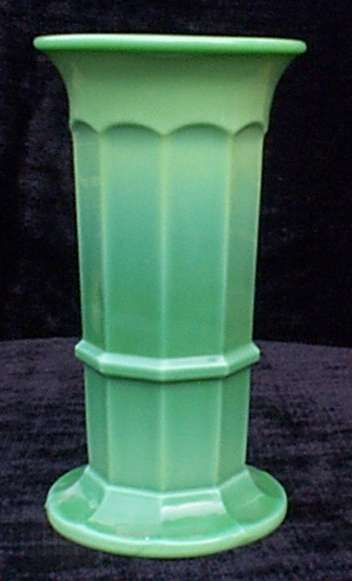 A
well known Davidson colour is Jade. Jade was very difficult to make and
produce an even colour. As collectors know, it sometimes appears as if no
two Jade pieces are the same colour! Jade production only lasted 3 years and
ceased in 1934. A
well known Davidson colour is Jade. Jade was very difficult to make and
produce an even colour. As collectors know, it sometimes appears as if no
two Jade pieces are the same colour! Jade production only lasted 3 years and
ceased in 1934.A Royal Blue bowl was to earn Davidson a Diploma of Merit at the Paris Exposition in June 1937. This is surprising as production of Royal Blue had ended in the previous year. Production of Royal Blue (or "special blue" as it was originally named) began on the 3rd January 1936 when 6 34 SD Flower bowls were made. Production began in earnest on the 8th January 1936 and most of the the Royal Blue was made in January and February of that year. Smaller batches were produced in May, July and September 1936, with 10" 712 vases being the very last items made. The Davidson accounts do record a single batch of a No 81 lens being made
in Royal Blue in September 1939. Whether this is actually the same shade of
Blue is uncertain. |
|
The table below details all of the Royal Blue made. The quantity is the number of items which passed inspection and for which the glass maker was paid. This is the closest figure we have to the number actually made.
Smoke was also introduced in 1936 - the first production trial being on the 17th July 1936. Up until 1939, smoke was reserved to a very limited range of styles which consisted of the 310 and 311 bowls and the 49 dish. Smoke became more widely used with the introduction of the Ripple range in 1939. |
Peach had an even shorter life span than Royal Blue. It was only made in the first 3 months of 1937. More surprisingly it was limited to just the 320 and 321 Flower sets and items in the new Grecian range. The complete production in Peach was:
It is not known why peach was made for such a short time in the 1930's. It was made in much larger quantities after the war. |
|
Davidson produced other colours which were reserved for industrial glassware. For Example Ruby was only used in items such as obstruction lights. In the early 1940s they also made glassware for the RAF (RAF Yellow, RAF Green and RAF Red). Coloured glass was also used for some of the Jacobean and Jewelray range for Clayton Meyers. Colours included Amber, Rose, Blue and Emerald. When Davidson bought the rights to the Chippendale range, they started to make some of the styles in Amber and Green. The 1445 flower bowl was also made in Amber Cloud and Green Cloud. |
New Styles
As well as new colours in 1923 Davidson started to produce more fancy glassware. During the 1920s some of their most well known
styles were created. Lack of available documentation makes it difficult to pin
down the exact year when some styles were introduced. Also surprisingly Davidson
did not register many of these designs. Indeed between 1918 and 1930, only 7 new
designs were registered, of which two were flower supports (The 'Teams' and
another which does not appear in their catalogues) and one was a piece
of industrial glass. The four other styles were the 695 pattern, the 737 pattern, a
comport and a fruit bowl.
Some of the new designs introduced in 1923 included the Tutankhamen bowl, Glass Salad Servers and a range of 'Hygienic' glassware (i.e. bowls with lids). Two years later they introduced the 697 Bowl and Candlesticks, the S696C flower set and the 1910M flower bowl. The 697 candlesticks could be converted for use as table lamps. Hors d'oeuvre sets were also becoming popular and Davidson started making sets.
By 1931 the full range of 1910 bowls and vases was in production, as well as items such as the 279 Column vase 293 and 294 vases and the 700 series of flower bowls and vases.
Between 1931 and 1933, no new ranges of glassware were introduced. This perhaps reflected the economic conditions of the period. As we have seen, this lack of new styles was more than compensated by the introduction of many new colours.
The last half of the 1930s was, by comparison, very productive for Davidson. They introduced a number of new glassware ranges and registered 17 new designs. The acquiring of the Chippendale design added to their already large range of products.
|
The first production runs for this range were as follows: 34SVG, 34 VG, 34F and 34LF - 7th March 1934 Originally Davidson had planned to use a different numbering system for this range. This was:
The two rarest styles in this range are the 34 LF and the 34/10. The 34 LF was a large version of the 34 SLF, but very few examples appeared to have been made. The 34/10, was made to accept the No 10 Grid fitting. It was made in both Amber and Green Cloud Glass in 1934, yet does not appear in any known Davidson catalogues. We do not know of any examples in any Cloud Glass collection. Consequently we do not known what it would have looked like.
|
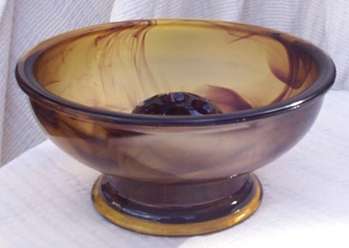 The No 26 Flower Bowl was also introduced in late 1934. This featured a
patented flower block which had three lugs to hold the bowl in place. The patent
was not issued to Davidson, but to Frederick Atkinson of London. It was also
three years between the patent being granted and the first production of the No
26 bowl. The No 26 Flower Bowl was also introduced in late 1934. This featured a
patented flower block which had three lugs to hold the bowl in place. The patent
was not issued to Davidson, but to Frederick Atkinson of London. It was also
three years between the patent being granted and the first production of the No
26 bowl. |
 Two new trinket sets appeared in 1934, the 330 and 340. The 340 trinket set
is unusual as it was never made in Cloud Glass. It was however, a very popular
style which lasted well into the 1950s. The 330 trinket set was the only 'Art
Deco' style trinket set made by Davidson Two new trinket sets appeared in 1934, the 330 and 340. The 340 trinket set
is unusual as it was never made in Cloud Glass. It was however, a very popular
style which lasted well into the 1950s. The 330 trinket set was the only 'Art
Deco' style trinket set made by Davidson
The 205 circular posy bowl was also introduced in 1935. |
 1935
also saw the introduction of Davidson's first table lamp. The Good Companion
lamp consisted of a glass stand and shade. In an advert Davidson described
the lamp as: 1935
also saw the introduction of Davidson's first table lamp. The Good Companion
lamp consisted of a glass stand and shade. In an advert Davidson described
the lamp as: "The Good Companion Table Lamp has been designed to tone with a room of almost any period. the outline is simple without being severe and the diamond design catches and reflects the light giving a very rich appearance. Unlike other glass table lamps the shade of the Good Companion is held firmly in position by a simple and decorative screw fitting - it cannot slip off. Added to this provision has been made to allow the shade to be tilted so that the light can pick out the pipe you have dropped or illuminate the wireless while you tune it in - an innovation that will at once be appreciated"
|
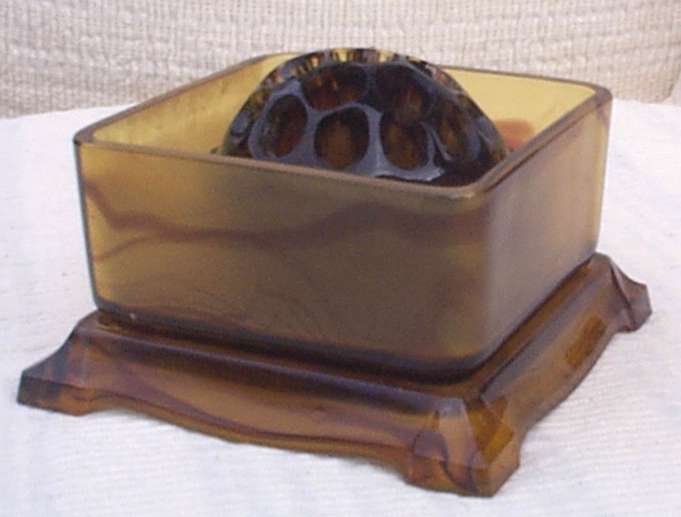 By comparison with the previous two years 1936 was a slow year for new
designs. Only one design was registered, the Hyacinth support for the 292 flower
bowl. In December the first of 4 designs in the Grecian range were introduced.
This design was sold as a loving cup for the Coronation of George VI. The first
production runs of the 320 and 321 flower set were made, with volume production
starting in early 1937. A new square ashtray was also introduced, the No 45. By comparison with the previous two years 1936 was a slow year for new
designs. Only one design was registered, the Hyacinth support for the 292 flower
bowl. In December the first of 4 designs in the Grecian range were introduced.
This design was sold as a loving cup for the Coronation of George VI. The first
production runs of the 320 and 321 flower set were made, with volume production
starting in early 1937. A new square ashtray was also introduced, the No 45.
|
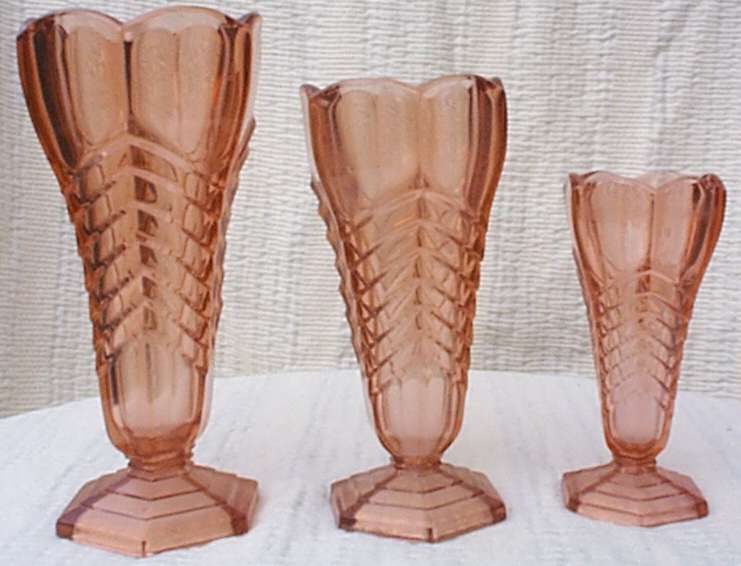 On the first of February 1938, the Davidson Company employed their first
designer W J G Fullerton. His influence was immediate, and in this year no fewer
than 7 designs were registered. These were the 937 pattern, the 295 "Chevron
Vase", the 258 Beer can, the 938 flower set, the 296 fan vase, the No 54 Safety
Ashtray, and the 940 pattern. Although not all of these designs can be
attributed to Fullerton, it is clear he made a large impact on the company. The
937 set was liked by Queen Mary, who purchased a fruit set in emerald green. On the first of February 1938, the Davidson Company employed their first
designer W J G Fullerton. His influence was immediate, and in this year no fewer
than 7 designs were registered. These were the 937 pattern, the 295 "Chevron
Vase", the 258 Beer can, the 938 flower set, the 296 fan vase, the No 54 Safety
Ashtray, and the 940 pattern. Although not all of these designs can be
attributed to Fullerton, it is clear he made a large impact on the company. The
937 set was liked by Queen Mary, who purchased a fruit set in emerald green.Both the fan and chevron vases were still being made in the 1960s. |
 A new trinket set was also to appear in 1938. The seven piece set came with a
scent spray - the only known scent spray to have been made by Davidson. This was
also Davidson's last design of trinket set. A new trinket set was also to appear in 1938. The seven piece set came with a
scent spray - the only known scent spray to have been made by Davidson. This was
also Davidson's last design of trinket set.
|
 The Globe lamp was also first made in 1938. This lamp had a spherical shade with a
chrome ring around the centre to keep the two halves of the shade together. The
base was made either in black glass or plastic. The chrome ring was reminiscent
of the rings of Saturn and this gives it the name it is known as by collectors.
Like the Good Companion lamp, this design was in production in the late 1950s. |
 Fullerton's
most remembered design, the 'Ripple' range was introduced in early 1939. The
only other style introduced in that year was the 940 pattern which was used
in flower sets, fruit sets and dishes. Fullerton's
most remembered design, the 'Ripple' range was introduced in early 1939. The
only other style introduced in that year was the 940 pattern which was used
in flower sets, fruit sets and dishes.
The early 1940s saw a change to war time production. Coloured glassware went in 1942, production switched to industrial glassware (and ammunition!) and the making of toughened tumblers. It is interesting to speculate what other wonderful designs Davidson would have produced had not the war intervened.
|
The story of Davidson glass continues on our web
page Davidson Glass post WWII.
|
|
|
|
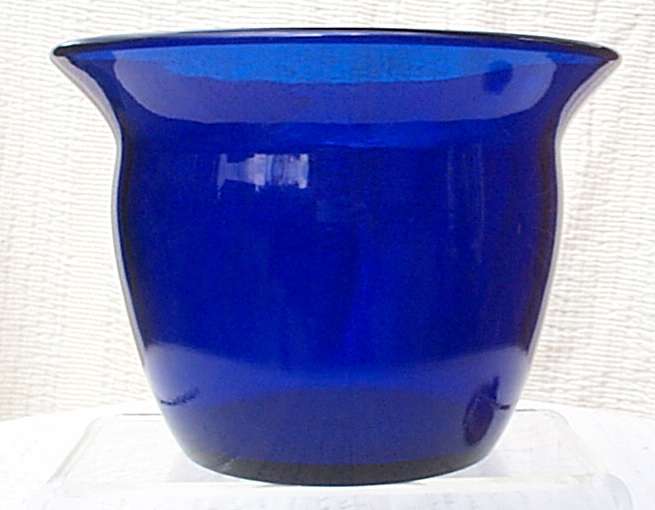 Royal Blue was an expensive colour to make and this is reflected in the
wholesale price. It was more expensive that even Cloud Glass. For example
the wholesale price per dozen of a 34 SD flower bowl was 11/6d for plain
colours, 17/- for Cloud and 27/- for Royal Blue. The high price is the
probable reason for its very short production run.
Royal Blue was an expensive colour to make and this is reflected in the
wholesale price. It was more expensive that even Cloud Glass. For example
the wholesale price per dozen of a 34 SD flower bowl was 11/6d for plain
colours, 17/- for Cloud and 27/- for Royal Blue. The high price is the
probable reason for its very short production run.  The 34 series of glassware was introduced in 1934 (hence the
name) and consisted of flower
vases and two piece flower sets. For the most part it was a short lived range,
only the 34D and 34SD flower sets were made after WWII. Production of the 34F
and 34SF ended in 1937, and the other styles between 1939 and 1942. The 34 LF
does not appear to have been made beyond 1934.
The 34 series of glassware was introduced in 1934 (hence the
name) and consisted of flower
vases and two piece flower sets. For the most part it was a short lived range,
only the 34D and 34SD flower sets were made after WWII. Production of the 34F
and 34SF ended in 1937, and the other styles between 1939 and 1942. The 34 LF
does not appear to have been made beyond 1934.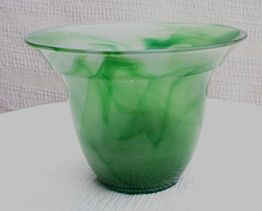 Only the 34 D and 34 SD, which came into production later in 1934, did not
start life with a different style number.
Only the 34 D and 34 SD, which came into production later in 1934, did not
start life with a different style number. Davidson
had their own problems differentiating between the 34 VF and 34 VG vases.
The same illustration is used for a 34 VG vase in a 1935 catalogue and a 34
VF vase in a 1940 catalogue. The only difference between these vases is the
rim. The picture, left, shows the rims of a 34 VF (in amber cloud) and a 34 VG vase.
Davidson
had their own problems differentiating between the 34 VF and 34 VG vases.
The same illustration is used for a 34 VG vase in a 1935 catalogue and a 34
VF vase in a 1940 catalogue. The only difference between these vases is the
rim. The picture, left, shows the rims of a 34 VF (in amber cloud) and a 34 VG vase. The following year saw the introduction of the 204 posy bowls. These came in 3
sizes (7.5, 9 and 12 inches) and in 3 basic shapes, the D with a turned down
rim, the F with a flat rim and the R with a rolled over edge. The number of
versions of the 204 was to increase markedly after the war, the most popular
being a version with a crinkled rim (204SS and 204C). The 204 was copied after the war by other
manufacturers such as Sowerby who produced a tri-cornered version in Purple
Cloud Glass.
The following year saw the introduction of the 204 posy bowls. These came in 3
sizes (7.5, 9 and 12 inches) and in 3 basic shapes, the D with a turned down
rim, the F with a flat rim and the R with a rolled over edge. The number of
versions of the 204 was to increase markedly after the war, the most popular
being a version with a crinkled rim (204SS and 204C). The 204 was copied after the war by other
manufacturers such as Sowerby who produced a tri-cornered version in Purple
Cloud Glass. 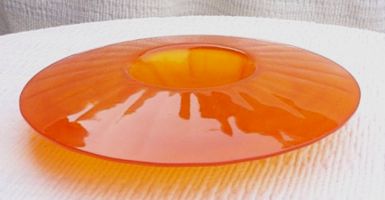 In the D and F styles, two versions were made. Most of the plain colour
versions had a faceted rim (called 'Optic' by Davidson) while Cloud colours had
a smooth rim.
In the D and F styles, two versions were made. Most of the plain colour
versions had a faceted rim (called 'Optic' by Davidson) while Cloud colours had
a smooth rim. 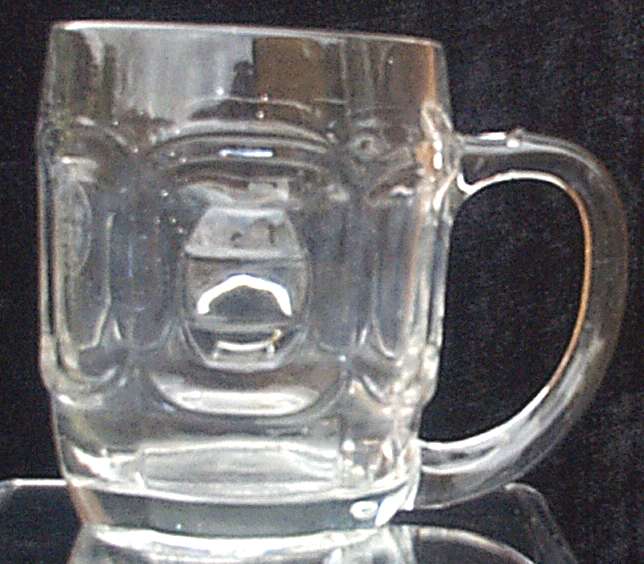 Another well known Davidson product was also introduced in 1935 - The
'Barrel' beer can. Davidson had always made drinking glasses and this was only
one of two designs of drinking vessel registered by Davidson in the 20th
Century. The 'Barrel' can was made in three sizes : pint, half pint and 12 fl.
oz. The design was so popular, particularly in Australia, that the Japanese
started to copy the design and undercut Davidson. To prevent this happening with
other styles Davidson started to registered new designs in both the UK and
Australia.
Another well known Davidson product was also introduced in 1935 - The
'Barrel' beer can. Davidson had always made drinking glasses and this was only
one of two designs of drinking vessel registered by Davidson in the 20th
Century. The 'Barrel' can was made in three sizes : pint, half pint and 12 fl.
oz. The design was so popular, particularly in Australia, that the Japanese
started to copy the design and undercut Davidson. To prevent this happening with
other styles Davidson started to registered new designs in both the UK and
Australia. The complete range of Grecian vases, dishes and bowls first appeared in 1937,
as well as the first large production runs of the 320 and 31 flower sets. Two
new styles of ashtray were also made, the simple round No 48 and the 'New and unique
Ashtray' , the No 46. This was a long thin ashtray with supports at
either end. The design prevented the cigarette from falling onto the table or
floor.
The complete range of Grecian vases, dishes and bowls first appeared in 1937,
as well as the first large production runs of the 320 and 31 flower sets. Two
new styles of ashtray were also made, the simple round No 48 and the 'New and unique
Ashtray' , the No 46. This was a long thin ashtray with supports at
either end. The design prevented the cigarette from falling onto the table or
floor.